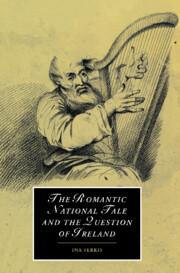Book contents
- Frontmatter
- Contents
- Acknowledgments
- Introduction: the awkward space of Union
- 1 Civic travels: the Irish tour and the new United Kingdom
- 2 Public address: the national tale and the pragmatics of sympathy
- 3 Female agents: rewriting the national heroine in Morgan's later fiction
- 4 The shudder of history: Irish Gothic and ruin writing
- 5 Agitated bodies: the Emancipation debate and novels of insurgency in the 1820s
- Notes
- Bibliography
- Index
- CAMBRIDGE STUDIES IN ROMANTICISM
1 - Civic travels: the Irish tour and the new United Kingdom
Published online by Cambridge University Press: 22 September 2009
- Frontmatter
- Contents
- Acknowledgments
- Introduction: the awkward space of Union
- 1 Civic travels: the Irish tour and the new United Kingdom
- 2 Public address: the national tale and the pragmatics of sympathy
- 3 Female agents: rewriting the national heroine in Morgan's later fiction
- 4 The shudder of history: Irish Gothic and ruin writing
- 5 Agitated bodies: the Emancipation debate and novels of insurgency in the 1820s
- Notes
- Bibliography
- Index
- CAMBRIDGE STUDIES IN ROMANTICISM
Summary
“What can possess you to go to Ireland?” exclaimed a friend of mine, “where the hedges are lined with pikes and blunderbusses?”
John Carr The Stranger in Ireland (1806)The roads in Ireland, even those called post-roads, are often in the very worst line of direction, and not unfrequently go zig-zag and round about, when there is no occasion for it.
The Reverend James Hall Tour Through Ireland (1813)To travel in Ireland in the early nineteenth century, these British tour-texts suggest, was not to know quite where you were. It was not just the propensity of Irish roads to become parodies of the very idea of a road, as in the Reverend Hall's account, nor the way in which boundary lines threatened to turn into screens for those bent on erasing those very lines, as in John Carr's not entirely serious evocation of the standard English motif of Irish insurgency. The problem was one of specifying the location. Officially, British visitors were simply moving about in another part of the single polity known as the United Kingdom, but Ireland continued to feel (as it long had in English eyes) remote and peculiar. Its incorporation into Great Britain in 1801 thus generated for the English the disconcerting situation nicely summed up by Seamus Deane: “They see Ireland in conventional terms as a foreign place much given to rebellion; whereas in fact it is home.”
- Type
- Chapter
- Information
- The Romantic National Tale and the Question of Ireland , pp. 18 - 45Publisher: Cambridge University PressPrint publication year: 2002



